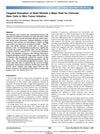TLDR Integrin-linked kinase is crucial for normal skin healing.
The study explored the role of integrin-linked kinase (ILK) in hair follicle stem cells and its impact on skin repair after injury. By inactivating the Ilk gene in these cells in mice, researchers found that ILK was crucial for normal epidermal regeneration and wound healing, with ILK-deficient stem cells showing delayed reepithelialization and reduced proliferation potential. Despite being able to support anagen follicle growth, these cells had impaired migration and reepithelialization capabilities, leading to delayed skin regeneration. The study involved eight animals per group and suggested ILK as a potential therapeutic target for healing abnormalities, highlighting its importance in basal keratinocyte attachment and differentiation.
 49 citations
,
October 2009 in “Cancer research”
49 citations
,
October 2009 in “Cancer research” Disrupting Stat3 in hair follicle stem cells greatly reduces skin tumor formation.
 168 citations
,
August 2009 in “EMBO molecular medicine”
168 citations
,
August 2009 in “EMBO molecular medicine” Epidermal stem cells are diverse and vary in activity, playing key roles in skin maintenance and repair.
 759 citations
,
February 2009 in “Current Biology”
759 citations
,
February 2009 in “Current Biology” Hair follicles are complex, dynamic mini-organs that help us understand cell growth, death, migration, and differentiation, as well as tissue regeneration and tumor biology.
170 citations
,
November 2007 in “The journal of investigative dermatology/Journal of investigative dermatology” Skin can heal wounds without hair follicle stem cells, but it takes a bit longer.
1279 citations
,
November 2005 in “Nature Medicine” 387 citations
,
November 2003 in “Journal of Investigative Dermatology” 561 citations
,
April 2003 in “Journal of Investigative Dermatology”
 December 2017 in “Chin J Cell Stem Cell (Electronic Edition)”
December 2017 in “Chin J Cell Stem Cell (Electronic Edition)” Hair follicle stem cells help skin wounds heal faster.
50 citations
,
July 2008 in “British Journal of Dermatology” 138 citations
,
March 2007 in “Experimental cell research” Only a few hair-specific keratins are linked to inherited hair disorders.
276 citations
,
January 2005 in “International review of cytology” 199 citations
,
January 2004 in “The International Journal of Developmental Biology” Hair follicle growth and development are controlled by specific genes and molecular signals.
29 citations
,
April 2003 in “Experimental dermatology” Human hair follicles grown in vitro maintain normal keratin patterns and structure.



